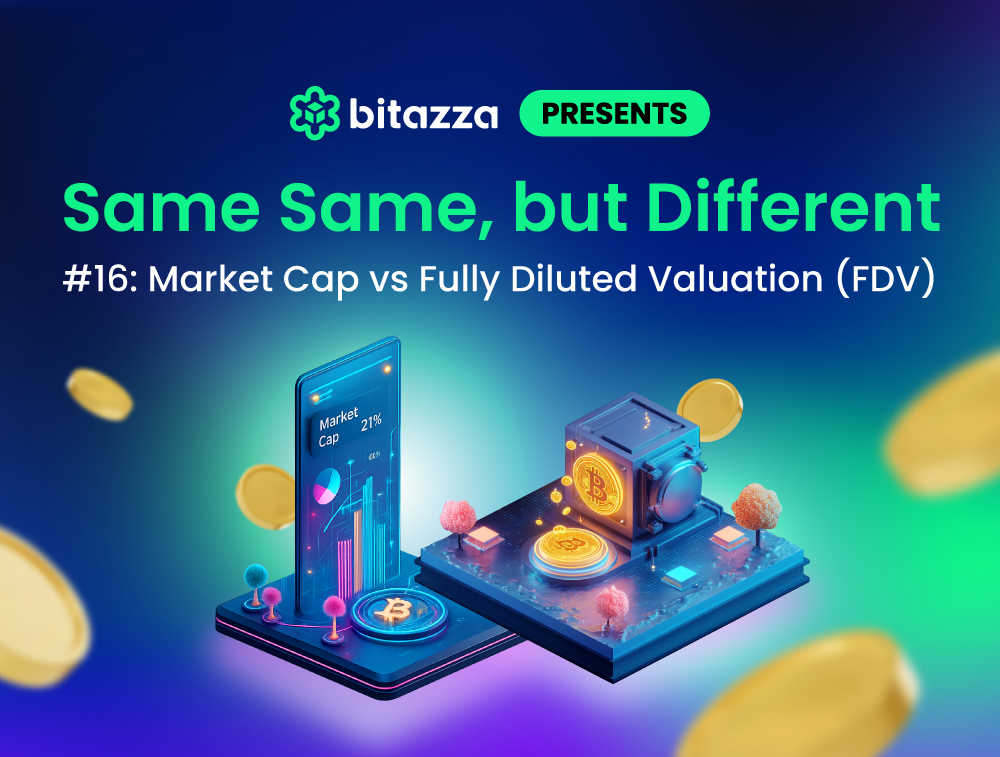Share this
Same Same, but Different #16— Market Cap vs Fully Diluted Valuation

When looking at a crypto project’s valuation, two numbers often show up: Market Cap and FDV (Fully Diluted Valuation). They both tell you how much a project could be worth, but they do so from very different angles.
One shows the current value of what’s already out there. The other shows the projected value if every single token eventually hits the market.
Let’s break it down.
Same Same: Both Are Valuation Metrics
For any investors looking at a project, the Market Cap and FDV are both ways to measure how much a token's project is worth, in theory. They’re calculated by using the token’s price but the difference is in what kind of supply they’re multiplying it by.
They both:
- Use the same token price
- Help investors gauge how “big” a project is
- Are useful for comparing across coins and tokens
However, they answer very different questions.
Different: Circulating Supply vs. Max Supply
Market Cap = the current value of the project
The project's market cap is based on the number of its tokens that are currently in circulation.
Formula:
Market Cap = Token Price × Circulating Supply
- Reflects the present market value
- Accounts only for tokens available to trade right now
- Used for comparing how “established” or liquid a token is today
Example:
If a token trades at $2 and there are 10 million tokens in circulation, then its Market Cap is $20 million. Even if there are 100 million tokens in total, only the circulating ones are counted here.
FDV = the potential value it could reach in the future
Fully Diluted Valuation assumes that all tokens—even those currently locked, vested, or unminted—are in circulation.
Formula:
FDV = Token Price × Max (or Total) Supply
- Shows how big the project could get if all tokens enter circulation
- Highlights potential dilution risks from future token unlocks
- Useful when evaluating tokenomics in early-stage or pre-launch projects
Example:
Using the same token at $2, but this time with a max supply of 100 million tokens. This also means its FDV is now $200 million. However, there are another 90 million tokens that could still be released in the future, which could possibly dilute the price for existing holders.
Quick Comparison Table
|
Metric |
Market Cap |
Fully Diluted Valuation (FDV) |
|
Based On |
Circulating Supply |
Total or Max Supply |
|
Reflects |
Current value in the market |
Projected value if fully issued |
|
Includes Locked Tokens |
No |
Yes |
|
Use Case |
Snapshot of current market presence |
Forecast of future valuation ceiling |
|
Risk Factor |
Lower (less speculation) |
Higher (depends on token release) |
|
Typical Use |
Measuring size & activity |
Evaluating long-term potential & dilution |
Why This Matters
Let’s say you’re comparing two tokens that you want to include in your portfolio for long-term speculation. You would need to find out if there are potential token unlocks ahead that might dilute the price over time.
Token A: Market Cap = $50M | FDV = $60M → Minimal dilution risk
Token B: Market Cap = $50M | FDV = $500M → Potential for big unlocks ahead
If you’re investing, this helps answer:
- Am I buying into current demand or inflated future supply?
- How much can this token grow over a period of time without massive dilution?
- Are the tokenomics sustainable?
The Market Cap tells you where the project currently stands. However, the FDV shows you how big it could possibly get in the future, but only if the price stays stable while more tokens are released. Same numbers, but different context.
Start Exploring
Whether you are here for investing, trading, learning about DeFi, or the broader Web3 space, Bitazza gives you one platform to explore it all with simplicity, security, and confidence.
Want to learn more about crypto and blockchain topics? Check out our blog.
Share this
- Crypto 101 (75)
- Trading (60)
- Crypto Weekly (46)
- Educational (43)
- Bitazza 101 (41)
- Featured (11)
- Missions (8)
- Market (6)
- Bitazza Insight (5)
- Research (5)
- Derivatives (4)
- TradingView (4)
- Education (3)
- Futures Trading (3)
- Freedom Shards (1)
- Freedom Token (FDM) (1)
- Intermediate (1)
- Product and features (1)
- Tether (1)
- Tether (USDt) (1)
- crypto exchange (1)
- December 2025 (3)
- November 2025 (6)
- October 2025 (10)
- September 2025 (8)
- August 2025 (17)
- July 2025 (29)
- June 2025 (13)
- May 2025 (14)
- April 2025 (12)
- March 2025 (8)
- February 2025 (8)
- January 2025 (8)
- December 2024 (7)
- November 2024 (5)
- October 2024 (14)
- September 2024 (9)
- August 2024 (14)
- July 2024 (3)
- June 2024 (48)
No Comments Yet
Let us know what you think